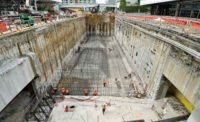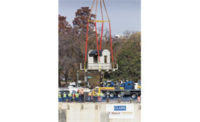Cultural Facilities
African American Museum Project Treads Lightly on Historic Site

Designers sought to make the International African American Museum appear to “float” above the site of the former Gadsden’s Wharf, where thousands of slaves were first brought to the U.S.
IMAGE BY PEI COBB FREED & PARTNERS

Shown here in November 2020, the construction project is scheduled for completion in September 2021, with the museum opening in early 2022.
PHOTO COURTESY OF THE INTERNATIONAL AFRICAN AMERICAN MUSEUM

Architects sought to make the museum appear to float above a 13-ft-tall pedestrian plaza connecting to adjacent gardens.
RENDERING BY PEI COBB FREED & PARTNERS

A view of the pedestrian plaza’s construction in late 2020.
PHOTO COURTESY OF THE INTERNATIONAL AFRICAN AMERICAN MUSEUM

Project designers sought to note the historic line of Gadsden’s Wharf with a 24-in.-wide stainless steel band that cuts on a slight diagonal through the full width of the museum grounds.
IMAGE BY PEI COBB FREED & PARTNERS AND HOOD DESIGN STUDIO

Contractors give credit to project suppliers and distributors for ensuring on-time delivery of materials despite impacts from the COVID-19 pandemic.
PHOTO COURTESY OF THE INTERNATIONAL AFRICAN AMERICAN MUSEUM

The museum required 290 75- to 90-ftlong, 14-in.- sq concrete foundation piles.
PHOTO COURTESY TURNER CONSTRUCTION AND BROWNSTONE CONSTRUCTION GROUP







The 2.3-acre waterfront construction site for Charleston, S.C.’s $100-million International African American Museum (IAAM) is often referred to as “hallowed ground,” and rightfully so.
Beginning in the late 1760s, the site was part of Gadsden’s Wharf, the disembarkation point for tens of thousands of enslaved Africans brought to the U.S. until federal law shut down the slave trade in 1808. As many as 80% of African Americans alive today can trace their ancestry to those brought ashore at the Charleston wharf, making it, in the words of historian Henry Louis Gates, “ground zero” for Black history.
Elijah Heyward, IAAM’s chief operating officer, says that while the museum’s story could be told anywhere, “the very Charleston and South Carolina story that is rooted in the impact of this sacred site is most significant here, and we are grateful to have the honor of purpose attached to our location.”
Appropriately, the two-story, 41,800-sq-ft museum will literally and figuratively tread lightly on the site when construction wraps up in September. With only 18 columns supporting the Danish brick-clad, cantilevered steel-frame structure, Pei Cobb Freed & Partners lead designer Matteo Milani describes the museum as “floating” 13 ft above a pedestrian plaza linking adjacent gardens and providing unobstructed views of the Cooper River and the Atlantic Ocean beyond.
“The site is the essence of the design,” adds Milani, whose firm collaborated on the design with Moody Nolan of Columbus, Ohio. “It’s clear that this is a unique building for a unique location.”
Hallowed though it may be, the site nevertheless presented some conventional challenges for the construction management at-risk team of Brownstone Construction Group and Turner Construction, which began work on the roughly $58.5-million project in July 2019.
Brownstone project manager Bobby Teachey says recent development on adjacent sites provided some clues about what the project team would encounter as it prepared to excavate up to 15 ft deep for the foundation system. With only 12 ft separating the excavation edge from an aging seawall and the Cooper River, the site’s water table lay only 3 ft below the surface.
“The site is the essence of the design. It’s clear that this is a unique building for a unique location.”
– Matteo Milani, Lead Designer, Pei Cobb Freed & Partners
To make the saturated substrate suitable for construction, site contractor Gulf Stream Construction of Charleston first drove 78 60-ft-long sheet pile reinforcements—for a total of 180 linear ft—parallel to the seawall, along with an addition 1,400 linear ft of sheet piles around the jobsite. Crews then installed a full-perimeter dewatering system combining stone-filled trenches with piping and well points.
The excavation would uncover many undocumented building foundations and centuries-old timber cribbing piles once used to stabilize marshland. Then began what Teachey only half-jokingly calls “the fun part”—driving more than 290 75- to 90-ft-long, 14-in.-sq concrete foundation piles through odorous, quicksand-like “pluff mud” to the chalky Cooper Marl.
Overall, Teachey says, “the site lived up to expectations” with few surprises. He also credits the dewatering system for helping sustain progress on the foundation through a summer and fall mercifully lacking in hurricanes and other large storms that typically menace Charleston. After one rainy weekend totaling just over 3 in., Teachey adds, “the excavated site was pumped down by lunch on Monday, and we were ready to go.”
Another benefit was Brownstone-Turner’s application of lean construction practices, such as utilizing a pile fabricator located roughly a mile away. Pairs of piles were delivered throughout the day, typically arriving in time to be queued up for driving.
“We drove about 14 piles a day, and there were never any staging issues,” Teachey says, noting that communication with residents of adjacent high-rise condominiums largely averted noise and vibration complaints. Perimeter vibration monitors recorded no excessive readings, “except when a squirrel bumped one,” Teachey says with a laugh.
|
Related Link |
With the foundation topped with pile caps interconnected with cast-in-place beams, the process of implementing IAAM’s innovative light-touch surface structure began. Framed with 1,110 tons of long-span steel beams, the 426-ft-long, 84-ft-wide building is supported on two rows of columns arranged in a 48-ft-sq grid. Each column has a 5-ft-dia core of reinforced 5,000-psi concrete and is clad with the same oyster shell tabby finish being used for most of the pedestrian plaza.
Because the museum’s perimeter cantilevers 15 ft, 10 5/8 in. from the center of the columns, the beams incorporate a ¾-in. upward camber that Teachey says is gradually leveling out as designed with the addition of more than 161,000 bricks to the facade.
The miniscule amount of vertical movement did require Brownstone-Turner to resequence some of the project’s interior work, such as rescheduling installation of the first level’s 32,000-sq-ft interior stucco ceiling until February, when most of the exterior masonry will be installed.
“We didn’t want to risk having to do rework on the ceiling as the camber comes out, and the change doesn’t affect the overall schedule,” Teachey says.
Outpacing the Pandemic
With safety protocols implemented as the spread of COVID-19 accelerated in March, the IAAM project never had a coronavirus-related shutdown. Indeed, Teachey says the outbreak affected the project’s supply chains far more than its people.
“We were in a good place having locked in our major material orders, but there were concerns about getting the bricks over from Denmark,” he says. “Thanks to good work with our suppliers and distributors, the bricks arrived on time by both air and sea.”
The Brownstone-Turner team is currently installing drywall for the museum galleries and the 15,000-sq-ft penthouse level that will contain offices and mechanical equipment. Other work on tap for the coming months includes adding wood trim and glass for the overlooks at the museum’s waterfront balconies and installing twin monumental staircases that will bring visitors up from the glass-enclosed plaza level into the double-height sky-lit atrium.
To complement the IAAM’s indoor exhibits and programs, the African Ancestors Memorial Garden will incorporate a variety of low-country landscape elements as well as a reflecting pool to signify the edge of Gadsden’s Wharf as it was at the beginning of the 1800s. “The garden advances the idea of our museum experience being buttressed as a site of memory,” Heyward says.
As the IAAM begins to transition from construction to exhibit design in anticipation of the scheduled early 2022 opening, Dale Collier, Brownstone president, believes the collaboration that brought the museum from concept to reality is a fitting complement to its role of sharing the unique and often unappreciated history of the African American experience.
“Our shared construction knowledge and regional experience made the difference,” he says. “We knew the conditions we might encounter and the players involved and the need to have good communication with everyone involved.”
“A museum of this type at this location is going to be closely watched and scrutinized by the community,” agrees Mark Dent, vice president and general manager for Turner’s Carolinas operations. “While we have continually planned for contingencies and adapting to the unexpected, our No. 1 focus has been what the building represents and why we’re putting it up.”
That includes ensuring involvement by Charleston’s construction community, with more than 30 local contractors involved with the project.
“Our museum belongs to the citizens of Charleston, who have contributed their time, hopes and resources to bring our vision to reality,” Heyward says. “We would not exist without our invaluable partners.”












